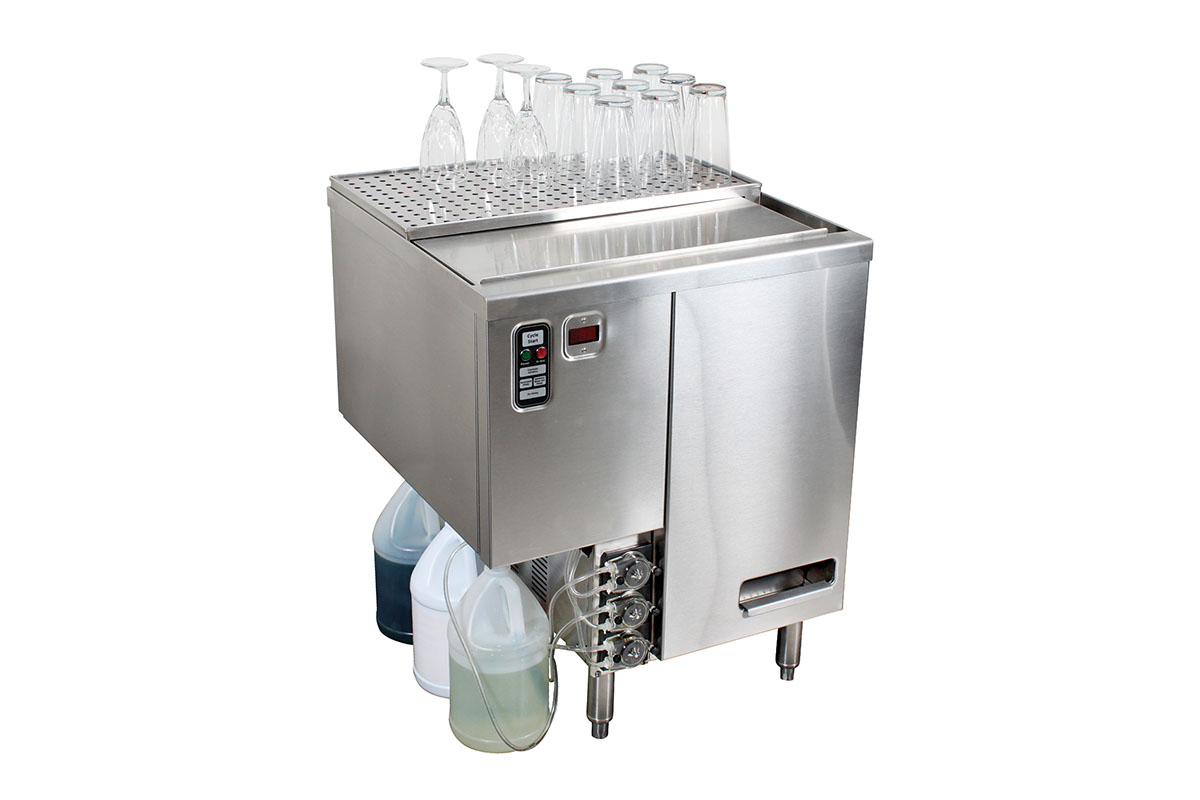‘Ware’ to Start With Specifying Glasswashers
Glasswashers save labor and space while ensuring glass cleanliness and beverage quality, but you’ll want to do your homework.

One of the biggest burdens on operators lately is the labor shortage. At the same time, the beer and spirits industry is booming. The number of craft brewery openings continues to grow, with retail dollar value in that niche coming in at 26.8% in 2021, a 21% growth over the previous year. In addition, 60% of American wineries’ sales are direct to consumer. Whether it’s at bars, restaurants, breweries or distilleries, more wine, beer and spirits will pour into glasses at a time when there are fewer employees to wash them, making now an opportune time to look at the benefits of glasswashers.
Glasswashers have been a part of the foodservice industry for many years, with rotary and conveyor types helping operations such as casinos and hotels handle thousands of glasses an hour. But as more operators see the advantage of having a glasswasher in front-of-house bar settings of restaurants or other customer-facing operations, rack-style glasswashers are making inroads in the industry. Adding a glasswasher to an operation can free up valuable labor for customer-facing operations, and also ensures sanitization. This equipment, designed specifically for glasses, brings other advantages over other undercounter-type machines or even three-compartment sinks. Some of those advantages include:
Walk-around space: Without the need to clean large prepware, the opening/door on glasswashers runs shorter than on undercounters. This means when open all the way it allows a few more inches of clearance, an important factor in tight bar situations.
Better ergonomics: The smaller opening height also allows the door to sit higher up on the unit, making it easier to load and unload.
Convenience factor: Having a glasswasher installed at the bar keeps the bartender up at the front of the house with customers, rather than having to go back and forth busing glassware to a back-of-house warewashing area.
Other advantages to glasswashers come in more specific features, depending on the model chosen for the type of operation. Here’s a guide to understanding some of the differences among glasswashers.
The High-Temp Advantage
Glasswashers come in either low-temp or high-temp varieties, with the primary difference between the two being the type of sanitization. Low-temp glasswashers use chemicals to sanitize the glassware, whereas high-temp glasswashers heat the water to at least 180°F to sanitize with hot water.
While low-temp glasswashers are less expensive than their high-temp counterparts, there are other costs to consider. The most obvious is the cost of chemicals over time, but there are other more subtle factors. “The chemicals left on a glass can affect the taste of a drink,” says one manufacturer. “When you take into consideration the cost of some of the high-end wines and cocktails, you can ruin a customer experience if you’re giving them a drink in a bad glass.” The chemicals also cut the amount of head on a pour of beer, which means craft brewers are pouring more beer per glass, cutting into potential profits. By sanitizing with hot water instead of chemicals, high-temp machines eliminate the risk of tainting the drink. One manufacturer includes an additional rinse cycle on its glasswashers, both high-temp and chemical sanitizing options, to ensure any detergent or chemical residue is cleaned off the glasses.

Low-chemical alerts and chemical autoprime features confirm glasses are clean and sanitized every cycle. Courtesy of Hobart.
Sanitization Considerations
Whether operators choose low-temp or high-temp machines, the end result needs to be clean, sanitized glasses. “Across the board we’re seeing operators have a much higher sensitivity to anything that will improve food safety, an issue that really became top of mind during the COVID-19 pandemic,” says one manufacturer. Some of the newer glasswasher machines have low-chemical alerts and a chemical autoprime feature to help ensure consistent cleaning and sanitization of glassware. This feature, the maker explains, automatically primes the chemical pumps after an empty chemical has been replaced to ensure the glasswasher is properly washing with detergent on every cycle, as well as sanitizing when using a chemical sanitizer.
Other models feature a heating element for temperature assurance. “Even for low-temp glasswashers, when installed in a bar, some distance from the water heater, it can be a challenge getting hot water to the location,” says one manufacturer. The heating element assists the vent heater to warm the water between washes. This is different from the hot water booster of high-temp glasswashers, which heats water from the standard of around 140°F from the hot water heater to the minimum 180°F of the sanitization cycle.
A Steam-Free Environment
A drawback of the extreme heat of the last rinse in a high-temp glasswasher cycle is the puff of steam emitted when the door is opened. More manufacturers are offering high-temp models with a heat recovery system available as an added feature. This technology grabs the steam produced in the wash and rinse cycles and turns it back into heat energy, which is then used to heat the water for the next rinse cycle.
Eliminating steam helps provide a more comfortable environment for customers and staff in the operation, as well as improving the longevity of bar furniture, as any additional moisture in the air can be detrimental to wood over time. Heat recovery units also provide environmental benefits. These glasswashers operate from cold water, which saves energy costs.

Certain glasswashers feature technology that eliminates steam, making for a more comfortable environment for customers and staff at the bar. Courtesy of Jackson Warewashing Systems.
Choosing the Right Glasswasher
When it comes to glasswashers, there are plenty of options, including rack-style, rotary and conveyor machines as well as choices on features such as heat recovery and noise suppression. Manufacturers of glasswashers recommend minding these considerations:
Location. Plan to install the glasswasher where it provides convenient access for bartenders while not being in the way for preparing drinks and serving guests. In addition, consider proximity to all the necessary utilities.
Atmosphere. A high-end establishment might put more importance on noise suppression and heat recovery features, while other types of restaurants might favor the cost-conscious low-temp glasswasher.
Volume. Glassware volume will determine whether to go with rack-style or rotary machines that handle anywhere from 800-1,200 glasses per hour, or instead to opt for the conveyor type that can wash up to 4,000 glasses per hour.
One of the biggest mistakes operators make when purchasing a glasswasher is going for the cheapest option, thinking they’re making a cost-conscious decision. Manufacturers recommend taking time to understand all the variables within an operation. Look at costs over time, from labor savings to chemical and energy use, to make the right decision.
Tips to Avoid Shock
Shock, whether from clinking glasses together or changing temperature quickly, can damage glass over time and make it more susceptible to cracks and ultimately breaks. Practice these tips to protect your glassware investments:
Glasswasher soft starts. The wash cycle on glasswashers, or the glasswasher cycle feature on some undercounter dishmachines, starts the wash cycle with less water pressure to reduce chipping and damage.
Correct racks for busing, washing and storing glasses. Racks designed for glassware help prevent glasses from bumping up against one another.
Allow glassware to come to room temperature. Extreme changes in temperature, whether from putting a glass that just contained ice water into a dishmachine for cleaning or pouring cold drinks into a glass right out of the dishmachine, can damage the integrity of the glass.
What To Know About Brush-Type Glasswashers

Photo courtesy of Bar Maid.
Brush-type glasswashers serve as one other option for bar operators looking to keep glasses clean. Compared with rack-style, rotary and conveyor glasswashers, they’re less expensive, install in seconds, use less water and chemicals and require little maintenance, according to one manufacturer.
Brush-type glasswashers work by sitting in a three-compartment sink’s first bay, filled with warm water and liquid detergent. They have five brushes and the center one spins inside an upside-down glass while the other four rotate around the outside.
If the equipment matches a facility’s needs, choices include upright and submersible units (both do the same job). Upright units tend to be less expensive, while a submersible model works well if there’s not enough room above the sink for an upright model. Also, look for a UL listing and NSF certification.
Sparkle Squad
Get your glassware gleaming with the latest glasswashers, rack or rotary style, from eight makers.

Jet-Tech
Model: 727E
High or low temp: High
Volume per hour: 15-30 racks
Water consumption: .52 gal per rack
Website: mvpgroupcorp.com

Glastender
Model: GW24 rotary glasswasher
High or low temp: Low
Volume per hour: 26 racks
Water consumption: 3 gal. per rack
Website: glastender.com

Perlick
Model: PKBR24 series rotary glasswasher
High or low temp: Neither; runs at 130°F to 140°F for wash and rinse
Volume per hour: 36 racks
Water consumption: 1.7 gal. per rack
Website: perlick.com

Moyer Diebel
Model: 601HTG
High or low temp: High
Volume per hour: 25 racks
Water consumption: 1.8 gal. per rack
Website: moyerdiebel.com

Jackson
Model: Delta HT-E-SEER-S
High or low temp: High
Volume per hour: 24 racks
Water consumption: .60 gal. per rack
Website: jacksonwws.com

Hobart
Model: LXGeR
High or low temp: High
Volume per hour: 24-30 racks, depending on cycle
Water consumption: .62 gal. per rack
Website: hobartcorp.com

Champion
Model: UH330 ADA
High or low temp: High
Volume per hour: 13-30 racks, depending on cycle
Water consumption: .63-.76 gal. per rack
Website: championindustries.com

CMA
Model: L-1Xe
High or low temp: Low
Volume per hour: 40 racks
Water consumption: .99 gal. per rack
Website: cmadishmachines.com
RELATED CONTENT
- Advertisement -
- Advertisement -
- Advertisement -
TRENDING NOW
- Advertisement -
- Advertisement -
- Advertisement -


